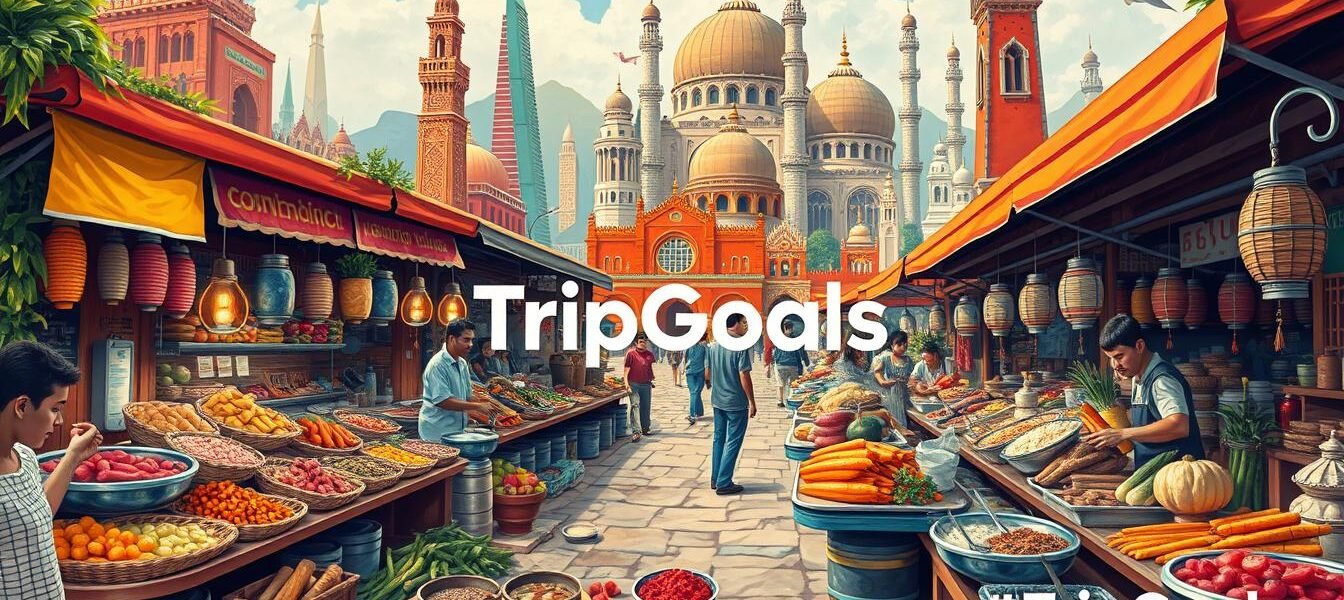“Food is our common ground, a universal experience.” James Beard’s words capture the heart of culinary tourism. It’s about more than just tasting food; it’s diving into a world of flavors and traditions. Food lovers, it’s about immersing yourself in the unique offerings of each place.
Culinary tourism is not just about food. It’s about cultural exchanges that make your travels richer. To make the most of your culinary vacation, plan well, research deeply, and be open to new experiences. As you travel through food, aim to create lasting memories. Maybe seek advice from experienced chefs1.
Key Takeaways
- Culinary tourism enriches travel experiences by blending culture and cuisine.
- Understanding your culinary trip goals enhances the journey of food exploration.
- Researching top culinary destinations can lead to memorable food adventures.
- Participating in local traditions and experiences increases cultural appreciation.
- Adventurous foodies benefit from engaging with expert local guides.
- Documenting your culinary experiences helps preserve lifelong memories.
Understanding Culinary Tourism
Culinary tourism is a big part of traveling today. It draws in food lovers who want to dive deep into local dishes. This type of travel is all about exploring food and drinks that are special to certain places. It also lets you connect with a place’s culture, history, and traditions.
Places like Southeast Asia are key in culinary tourism. They attract visitors who want to try street food, markets, and real dishes. These dishes share stories of tradition and new ideas2. The food here mixes different flavors, like sweet and spicy, that travelers love2.
Food travelers are not just after good food. They also want to learn about cultures and meet new people3. They might take cooking classes or visit markets. These experiences let them see how locals live and taste their everyday food. Every meal becomes a way to learn about a place.
The Rise of Culinary Travel Experiences
Culinary travel has grown by 15% each year, as more people want to dive into food experiences beyond just seeing sights4. This trend boosts local businesses’ earnings. In places known for food, 25% of tourism money goes to food-related activities, helping restaurants and food tours4. These spots see up to a 30% jump in sales4.
Now, 88% of travelers say finding new food spots is key when picking a place to visit, shaping their plans5. About 60% of those who travel in style look for places with great food, showing food’s role in travel5. Almost 1 in 5 travelers seek out food adventures, showing a shift towards food-focused travel5.
The Asia Pacific is leading in culinary tourism, making up over 37.8% of the global market in 20235. It’s known for its rich food culture and creative dishes that mix old and new flavors5. This has made culinary travel a key part of luxury tourism, also fostering connections and cultural understanding5.
The culinary tourism market was worth USD 91 billion in 2022 and is expected to hit USD 188 billion by 2030, growing 9.5% annually6. Trends now include experiential travel, eco-friendly dining, and healthy food options. With travelers wanting to learn about food on their trips, planning these experiences is more important than ever6.

| Key Statistics | Details |
|---|---|
| Annual Growth in Culinary Travel | 15% annually, highlighting a rising trend in immersive gastronomic experiences4. |
| Culinary Tourism Revenue Contribution | 25% of revenue comes from regions known for their culinary offerings4. |
| Boost in Local Revenue | 30% increase in revenue for culinary-focused areas4. |
| Travelers Prioritizing Culinary Experiences | 20% increase in travelers favoring culinary experiences over traditional sightseeing4. |
| Future Growth of Culinary Market | Projected to reach USD 188 billion by 2030, with a CAGR of 9.5%6. |
Culinary Trip Goals: Setting Your Food Travel Objectives
When you start a culinary journey, it’s key to know what it means to you. Think about what you want to get out of it. Do you want to dive into local cultures, learn new cooking skills, or find unique food experiences? These thoughts help shape your trip goals, making your travels more fulfilling.
Defining What Makes a Culinary Journey Meaningful
Your food travel goals should match what you hope to achieve. Maybe you want to try dishes that share a region’s history. Or perhaps you aim to learn cooking techniques to recreate your travels at home. Focusing on these goals will make your trip more memorable and enriching.
Identifying Your Personal Epicurean Adventure Goals
It’s crucial to set personal goals for your food adventures. You might aim to visit local food festivals, try certain dishes, or explore different cuisines. For more tips on making your culinary experiences better, check out this article. These goals will guide your journey, making it both enjoyable and satisfying.
Researching Best Culinary Destinations
For food lovers, picking the right place is key to a great culinary trip. Culinary tourism lets you dive into unique meals and find local foods that show off a culture. When planning your foodie trip, think about the tastes and the stories of the dishes you’ll try.
Why Destination Matters for Foodies
Your choice of place greatly affects your food trip. Places like Italy and Thailand offer different tastes that please everyone7. Also, more people want real experiences that let them connect with local traditions and tastes7.
Top Culinary Hotspots to Consider
Here are some top places to check out in 2025:
| Destination | Culinary Highlights |
|---|---|
| Italy | Regional dishes like risotto and authentic pizza |
| Mexico | Flavorful tacos and mole sauces |
| France | Gourmet meals and exquisite pastries |
| Morocco | Spices and slow-cooked tagines |
| Thailand | Street food such as pad thai and green curry |
Visiting these places will match your taste and give you a peek into their unique food cultures. Make sure to research local foods and dishes that interest you for a richer experience. This will help you understand each area’s food scene better.
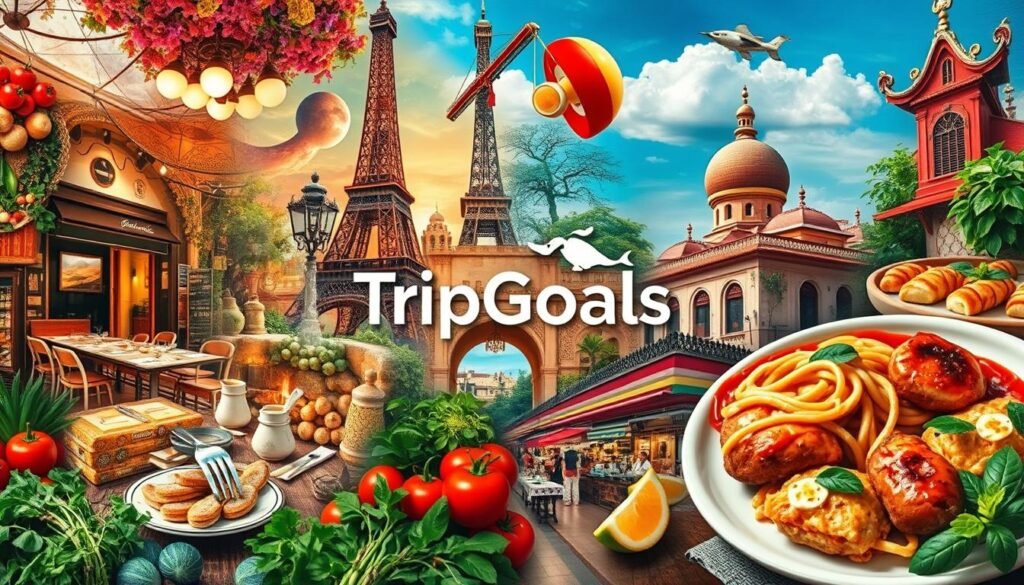
Planning Your Culinary Travel Itinerary
Creating a good itinerary is key for a great culinary trip. Mix dining, cooking classes, market visits, and food tours for a full experience. Being flexible helps you find hidden gems that make your trip even better89.
Working with famous chefs can make your 2022 culinary trip unforgettable. Some top itineraries are made with experts like Michelin-starred Dani and British chef Simon Rogan10. Don’t forget to check local food blogs and book popular spots early8.
Exploring local food traditions makes your trip richer. Remember, dinner times vary worldwide, like in Spain at 9 PM. This helps you fit in with local customs89. Cooking classes let you learn new recipes and make friends10.
The table below shows important things to think about when planning your culinary trip:
| Element | Description | Example |
|---|---|---|
| Dining Reservations | Book in advance for popular restaurants. | Michelin-starred dining experiences |
| Cooking Classes | Participate in classes to learn local recipes. | Paella cooking in Spain |
| Market Visits | Explore local markets for fresh produce. | Culinary walking tour in Florence |
| Food Tours | Join guided tours to sample diverse cuisines. | Street food tours in Bangkok |
Discovering Local Gastronomic Traditions
Exploring local food traditions opens a window into the deep food and culture connection in different communities. Each dish tells a story of history and local ingredients. It invites travelers to dive into unique experiences. The charm of food tours is not just in tasting local dishes but in connecting with communities.
How Food Reflects Culture and History
Food is a story of cultural heritage, showing traditions and histories of places. The Second Global Report on Gastronomy Tourism by the UN World Tourism Organization highlights the importance of respect for culture and tradition in culinary tourism11. Local dishes reveal customs passed down through generations. Each bite tells a story of a community’s history, economy, and politics.
Engaging with Local Culinary Practices
To truly get to know a place, you must engage with its food practices. Activities like visiting farmers’ markets, attending cooking classes, or joining family meals offer a hands-on look at food making. The report shows that cultural practices are key in culinary tourism, focusing on respect and authenticity11.
By participating, you connect with people, their stories, and customs. This enriches your food journey. Community restaurants that give back to locals also support cultural exchange12.
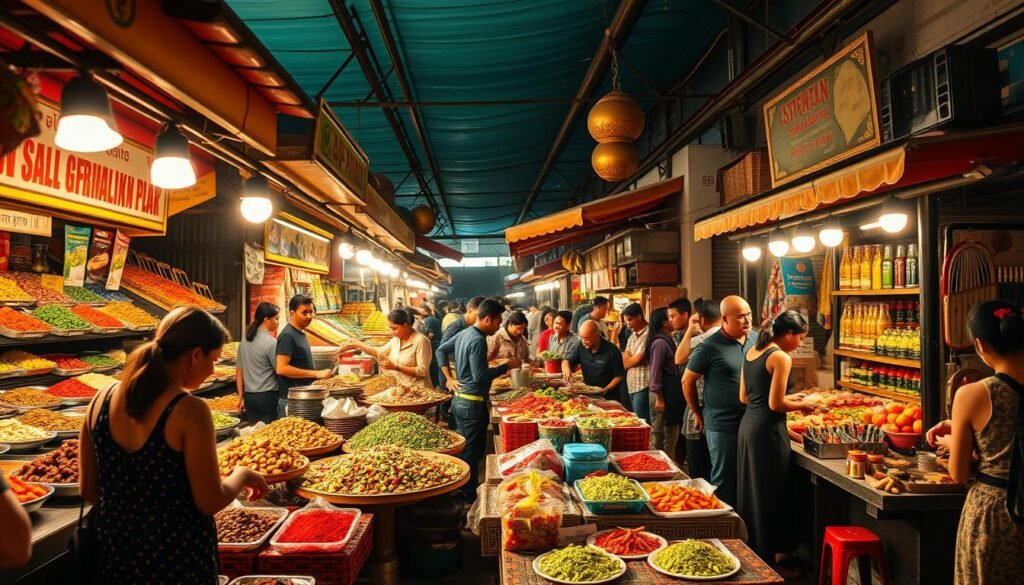
Immersive Food Experiences to Include in Your Journey
Exploring food tourism is key for a great cooking vacation. It lets you learn new cooking skills or dive into local tastes. These experiences make your trip even better.
Participating in Cooking Classes
Cooking classes offer a chance to learn from local experts. You improve your cooking and learn about local ingredients. This knowledge opens doors for more culinary adventures. Luxury culinary experiences are growing by 15% each year, showing their appeal to travelers13.
Exploring Local Markets
Local markets let you find unique ingredients and street food. They show the culture and history of food. Street food tourism has grown by 10% each year, showing its appeal13.
| Experience Type | Growth Rate | Target Segment |
|---|---|---|
| Cooking Classes | 15% growth year-over-year | Luxury Foodie Segment |
| Street Food Experiences | 10% increase in international tourists | Budget Foodie Segment |
| Foraging Tours | 8% increase in bookings | Foodie Adventurer Segment |
| Farm-to-Table Dining | 20% rise in eco-conscious travelers | Eco-Foodie Segment |
Trying these food experiences will make your trip unforgettable and rewarding14.
Finding the Best Food Tours
Choosing the right food tour is key to a great culinary experience. You can find many options to match your gourmet experiences wishlist. Local experts often recommend restaurants, adding value to guided tours.
Exploring on your own lets you find hidden culinary gems. Think about your travel style, budget, and interests when picking a tour.
Guided Tours vs. Independent Exploration
Guided tours offer curated experiences. Local guides share authentic tastes and dish histories. For example, food tours by experts showcase diverse local flavors and traditions.
Companies like Eat Like a Local ensure local vendors are fairly compensated15. Some tours focus on themes like Indigenous cuisine or farm-to-table dining. Decide what style fits your expectations best.
How to Choose the Right Food Tour for You
Look for tours that support local communities and fair practices. Choose tours led by BIPOC and community-driven initiatives16. Check customer reviews to ensure quality.
Be wary of very cheap tours that might not be fair to locals15. Make sure the tour is flexible and meets your dietary needs. This way, you can enjoy all the regional specialties you prefer.

Sustainable Culinary Travel Practices
Practicing sustainable culinary travel helps the planet and makes dining better. Supporting local producers and restaurants boosts your travel impact and local economies. Choosing eco-friendly dining lets you enjoy real flavors while protecting the environment.
Supporting Local Producers and Businesses
Building connections with local producers offers unique food adventures. London’s Borough Market, a 12th-century gem, draws thousands for fresh, local ingredients17. Paris’s Marché Bastille, with over 150 stalls, attracts top chefs, highlighting local agriculture’s value17.
These markets let you dive into local cuisine and support small farmers and vendors.
Eco-friendly Dining Choices for Food Enthusiasts
It’s crucial to pick restaurants that care about the planet. Silo in London serves meals with no packaging and composts, making dining eco-friendly17. Rhodora Wine Bar in Brooklyn is a zero-waste spot, showing sustainability doesn’t mean sacrificing taste17.
Places like Haoma in Bangkok, with its own seafood tanks and hydroponics, make your trip greener and tastier17.
Knowing our food choices affect the environment is key. Harvard T.H. Chan School of Public Health says agriculture is a big environmental problem18. Our tourism actions can help, especially since food waste is huge, with a third of all food thrown away yearly18.
By choosing sustainable dining, you help solve this issue and enjoy amazing food.
Documenting Your Food Travel Adventures
Writing down your food adventures is key to culinary travel. It helps you remember your trips and share your stories with others. Over 55 countries have been explored by top travel bloggers, making journals a source of inspiration19. You can record every moment and taste, creating a rich story of your food explorations.
Keeping a Culinary Travel Journal
Your journal is a place to write about dishes, dining spots, and people you meet. With 87% of millennials using social media for travel ideas, your stories can inspire others20. Keeping this journal captures your food journey and lets you relive happy memories.
Sharing Your Journey on Social Media
Sharing your food adventures online is crucial today. Instagram, YouTube, and TikTok let food lovers show off their travels with great visuals20. Use smartphones or drones to take amazing food photos, making your posts stand out20. Joining food-related hashtags connects you with others who love food travel, guiding them on their own culinary journeys21.
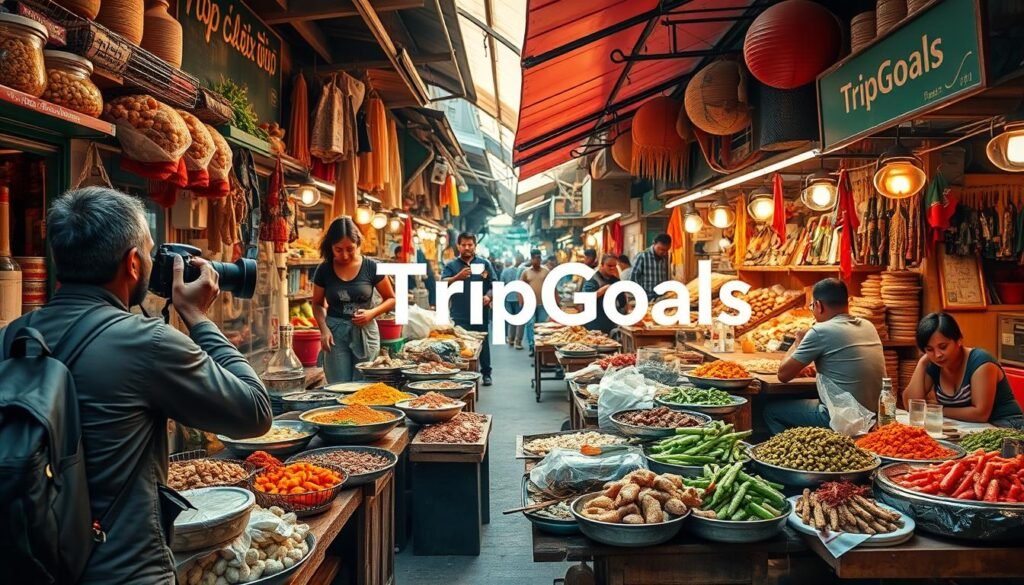
| Culinary Traveler Type | Percentage of Leisure Travelers | Approximate Number of Travelers |
|---|---|---|
| Deliberate Culinary Travelers | 8% | 12.6 million |
| Opportunistic Culinary Travelers | 4.7% | 7.6 million |
| Accidental Culinary Travelers | 4.4% | 7.1 million |
Participating in Culinary Festivals and Events
Food festivals are a great way for food lovers to dive into local tastes and celebrate regional dishes. These events are filled with culinary creativity. You get to meet chefs, local sellers, and food makers, learning about food traditions.
The Hawaiʻi Food & Wine Festival is a top event. It drew over 900 people to its Behind the Cellar Door event. There, 17 famous chefs, 8 top mixologists, and 22 winemakers, including 3 master sommeliers, were featured22. This festival not only showcases talent but also helps local food programs, supporting schools since 201122.
The culinary tourism market is expected to grow to USD 45.63 Bn by 2031, with a 18.8% CAGR from 202423. Food festivals make up 38.2% of this market, attracting tourists with their variety23. These events are lively, offering a chance to try many dishes at once.
Joining these lively food events can spark a love for food and broaden your culinary knowledge. The Hawaiʻi Food & Wine Festival, for example, offers networking and chances for culinary students to learn and find jobs22. These festivals are key to culinary tourism, promoting local ingredients and cooking traditions while celebrating food sharing.
Embracing Street Food Culture
Street food culture is a key part of our culinary world. It offers rich, authentic experiences that highlight local flavors and traditions. Cities worldwide have lively street food scenes, where you can find diverse dishes that show off the region’s heritage.
Street food vendors are crucial for millions of people, providing jobs and boosting local economies24. By trying these dishes, you get to taste unique flavors that formal restaurants often miss.
Why Street Food is a Must-Try Experience
Eating street food lets you truly explore a city’s food identity. In Asia, for example, there’s a vast array of traditional street foods, like in Thailand, Vietnam, and India24. Food lovers often go on food tours to taste these authentic flavors and enjoy the lively atmosphere of street vendors24.
Street food is more than just food; it’s a way to connect with a culture. It offers a real taste of the local way of life.
Finding the Best Street Food Stalls
Finding top street food stalls is an adventure that requires local tips. Talking to locals can lead you to hidden spots run by skilled vendors who offer samples25. Visit food markets early to see them in full swing and enjoy fresh flavors as locals do their shopping25.
To make your experience even better, learning a few basic phrases in the local language can help. It builds rapport with vendors and enriches your culinary journey.
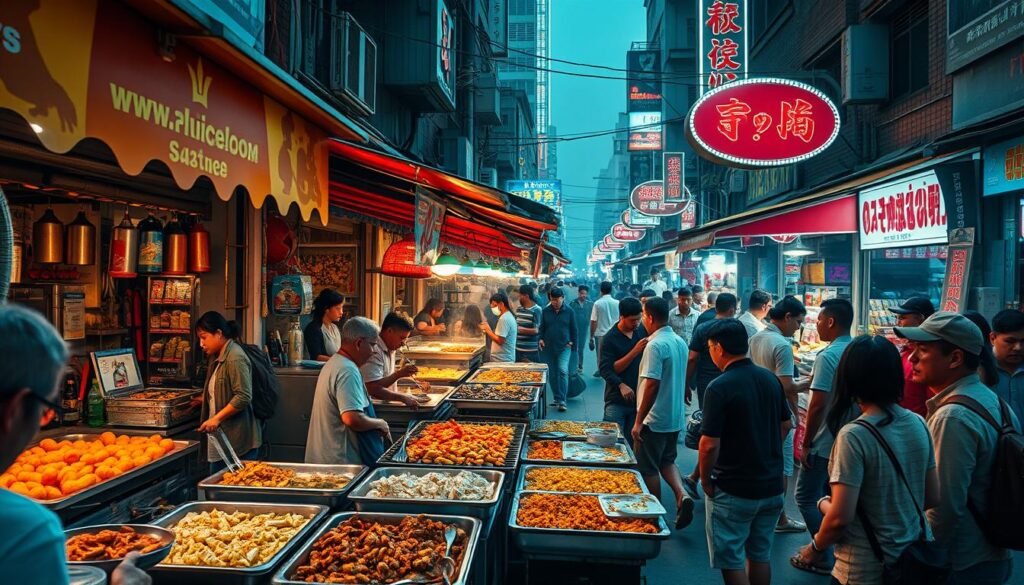
Exploring Food and Drink Pairings
Food and drink pairings make dining better by combining flavors and setting the scene. About 80% of fancy restaurants offer wine with their meals, showing how important it is26. Most people like red meat with red wine, a choice made by 95% of diners because of the taste26.
Finding the right mix of dish and wine is key. Around 70% of diners look for this balance when picking what to eat26. They often choose based on where the food and wine come from, with 85% considering local traditions26. This makes the food and drink more meaningful and enjoyable.
More places, like BBQ smokehouses, are now offering food and drink pairings. NOLA Smokehouse & Bar, for example, has seen a 20% rise in demand for these experiences26. Sauvignon Blanc is a top choice for pairing with eggplant, showing the importance of the right drink with food26.
In Dallas, many food lovers enjoy trying different wine and food pairings. This interest is growing, especially for German wines, which are available at various prices in local stores27. As people explore new tastes, they look for healthy options and wines with the right alcohol content27.
Getting the balance right in food and wine pairing is key. 90% of diners say it makes their meal better26.
Connecting with Local Chefs and Artisans
Meeting local chefs and artisans makes your food journey special. It turns into a meaningful cultural adventure. You might find unique ingredients and learn about traditional cooking methods. Food tours help keep local food traditions alive and support small businesses28.
Talking to chefs at markets or cooking classes makes food come alive. Many travelers seek these real experiences28. These chats deepen your respect for the stories behind each dish. Working with local food bloggers and critics can also boost your brand’s local presence29.
Look into famous culinary programs that link you with top chefs. For example, La Cucina al Focolare builds lasting bonds with local artisans. You’ll explore beautiful islands, taste fine wines, and learn from chefs with Michelin stars30.
These connections offer you real experiences that many tourists miss. You’ll take home recipes, stories, and a deeper understanding of food’s role in culture. Social media helps share these moments, attracting more food lovers29.
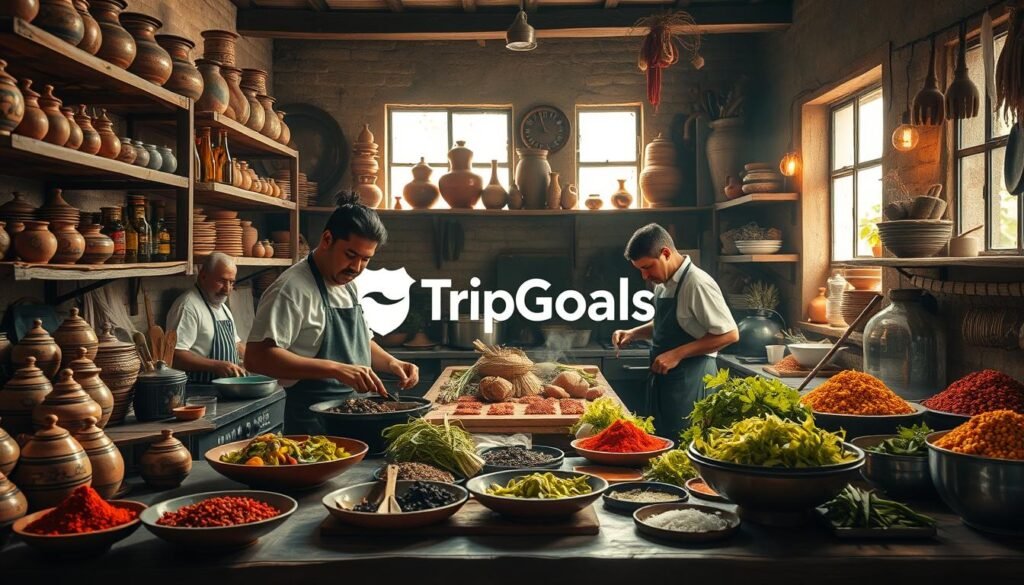
Addressing Dietary Restrictions While Traveling
Traveling with dietary restrictions can be tough, but with the right planning, you can enjoy your food adventures. It’s key to find dining tips that fit your needs. This way, you can have safe and tasty meals.
Learn local phrases for your dietary needs to talk to restaurant staff. Remember, foods like peanuts, tree nuts, milk, and soy can be risky. Always ask about ingredients in your food31.
Useful Tips for Dining Out with Dietary Needs
Start by researching restaurants that meet your dietary needs. Look for places that show their menus online and offer options you can eat. Always check nutrition labels for allergens if you buy packaged foods31.
Also, carry safe snacks for in-between meals. This helps avoid any food problems.
- Research local dining options known for accommodating specific dietary needs.
- Use mobile apps to find restaurants that cater to food allergies and intolerances.
- Engage with local communities online to gather recommendations for safe dining.
- Consider cooking classes that focus on dietary-friendly recipes for hands-on experience.
It’s crucial to have emergency tools like EpiPens for severe food allergies31. Make sure trained staff know how to use these devices in emergencies. By following these tips and planning well, you can have fun and safe meals while traveling.
The Importance of Culinary Education While Traveling
Culinary education opens doors to the rich world of regional cuisines when you travel. By taking cooking classes, you dive into local food culture. This immersive experience lets you appreciate flavors, techniques, and culinary history more deeply.
Taking Classes or Workshops
Cooking classes offer a unique learning experience, from bustling markets to cozy kitchens. You can find courses on regional specialties worldwide. For example, one traveler took classes in 12 countries, from Italy to Mexico32.
The cost of these classes varies. In India, a course cost just $12 USD, while in Europe, it can be over $100 USD32. Classes usually last 3 to 8 hours, including market tours and coffee breaks32.
Meeting others in these classes can lead to new friendships. These connections are built on shared interests in food. People prefer smaller, family-run classes for a more personal experience32. You can learn practical cooking skills, like preserving garlic or chopping onions32.
Culinary tourism is booming, showing a shift towards experiential travel33. This trend emphasizes sustainability and local ingredients. It offers various career paths and educational programs for those interested33. Technology makes learning about local cuisine easier, with online classes and digital guides33.
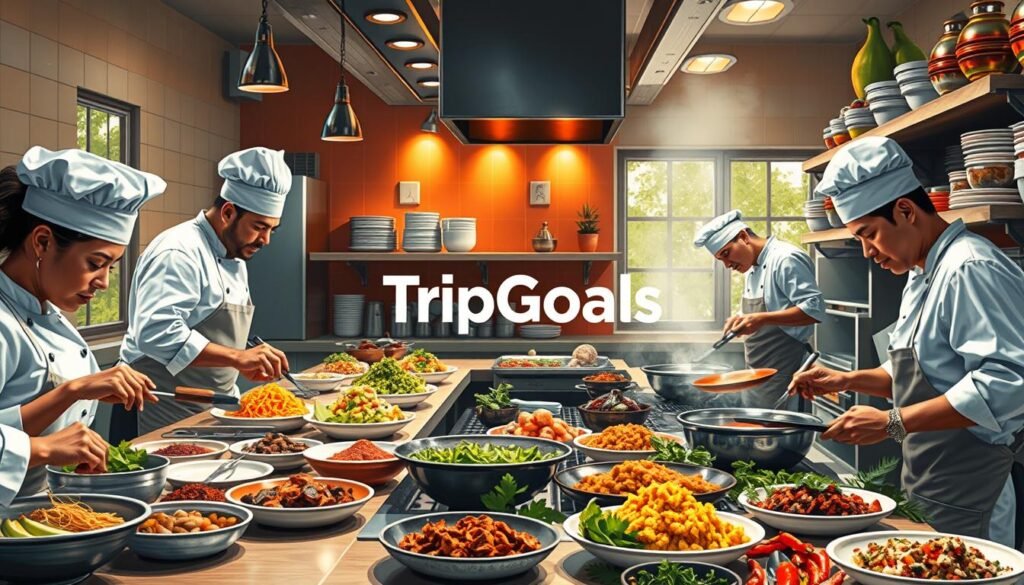
Conclusion
Going on a culinary trip is more than just eating great food. It’s a mix of culture, learning, and a personal bond with food. By trying local dishes, you make memories that last a lifetime. Food and drinks are big parts of travel, with most visitors eating out, showing how important food is in travel34.
Starting your food adventure can really enrich your life and help local economies. People all over the world love trying new foods, making dining out a big part of travel34. This desire for new things makes travelers eager to try local foods, making their trip even better35.
Plan your food trips with care, focusing on being green and helping the community. Food tours and cooking classes let you dive into local flavors and stories. This way, you not only eat well but also learn about the culture behind each dish. For more on culinary tourism, check out this link.
FAQ
What is culinary tourism?
How can I set my culinary trip goals?
What are some best culinary destinations to consider for travel?
What should I include in my culinary travel itinerary?
How does local food reflect cultural traditions?
What are immersive food experiences I should consider?
How can I choose the right food tour?
What sustainable practices should I follow in culinary tourism?
How do I document my food travel experiences?
Why should I participate in culinary festivals and events?
What makes street food an essential part of culinary tourism?
How can food and drink pairings enhance my culinary experience?
How do I connect with local chefs and artisans?
What should I consider if I have dietary restrictions while traveling?
Why is culinary education important during travel?
Source Links
- https://letseattheworld.com/about-us/
- https://fhafnb.com/glossary/culinary-tourism/
- https://coffeyandtea.com/tourism/what-is-food-tourism/
- https://curatatravel.com/blogs/curata-travel-blog/culinary-tourism-exploring-the-world-through-taste
- https://spaexecutive.com/2024/12/10/2025-travel-trends-culinary-travel/
- https://www.linkedin.com/pulse/culinary-tourism-market-strategies-aligning-growth-goals-ponze/
- https://drifttravel.com/culinary-journeys-tasting-the-world-one-bite-at-a-time/
- https://www.wanderwithwonder.com/how-to-plan-a-culinary-trip-around-the-world/
- https://www.tullyluxurytravel.com/gourmet-travel/
- https://www.blacktomato.com/us/experience-types/food-travel/
- https://www.linkedin.com/pulse/culinary-tourism-window-local-culture-maheima-kapur
- https://planeterra.org/culinary-tourism-for-sustainability-exploring-local-food-cultures-and-farm-to-table-experiences/
- https://www.tamzexplores.com/exploring-cultural-cuisines/
- https://userway.org/blog/accessible-dining-experiences/
- https://www.tripsavvy.com/ethical-food-tours-5200892
- https://www.exploreworldwide.com/experiences/food-drink-tours
- https://www.hilton.com/en/travel/articles/sustainable-culinary-vacations/
- https://www.yugenearthside.com/blog/sustainable-tourism-food
- https://thetravelbite.com/about-travel-bite-food-travel-blog/
- https://duffelbagspouse.com/food-photography-culinary-travel/
- https://industry.traveloregon.com/wp-content/uploads/2014/03/2006-Profile-of-Culinary-Travelers.pdf
- https://kapionews.com/index.php/2024/12/02/culinary-students-assist-culinary-icons-at-annual-food-festival/
- https://www.coherentmarketinsights.com/industry-reports/culinary-arts-tourism-market
- https://www.articlealley.com/list/culinary-adventures-discovering-unique-street-foods-to-try-worldwide-23065
- https://www.roaminghighways.com/2023/12/19/10-ways-to-embrace-roadside-local-cuisine-and-food-tours/
- https://www.nolasydney.com/the-art-of-pairing-food-and-drink-for-a-memorable-dining-experience/
- https://rockinredblog.com/2017/04/12/food-wine-pairing-a-cross-cultural-pairing/
- https://ieatfoodtours.co.uk/blog/the-significance-of-food-tours-in-tourism-development-i-eat-food-tours/
- https://www.leaddigital.com/blog/collaborating-with-local-bloggers-and-food-critics/
- https://www.theflairindex.com/women/peggy-markel-her-epic-culinary-adventures/
- https://www.linkedin.com/advice/0/how-can-you-talk-food-allergies-dietary-restrictions
- https://www.twowanderingsoles.com/blog/why-you-should-take-a-cooking-class-on-your-next-trip
- https://avlonshikshaniketan.com/the-art-of-culinary-tourism-blending-food-with-travel-education/
- https://mountainscholar.org/bitstreams/f2fb9238-8800-4bde-9014-073b850173f2/download
- https://thetravelpsychologist.co.uk/f/what-is-food-tourism-and-why-is-it-growing-in-popularity/
